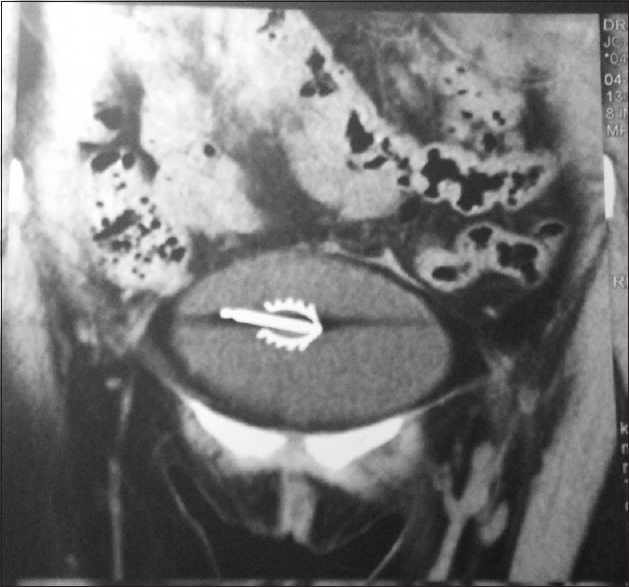Translate this page into:
An unusual case of recurrent urinary tract infection
This is an open access article distributed under the terms of the Creative Commons Attribution-NonCommercial-ShareAlike 3.0 License, which allows others to remix, tweak, and build upon the work non-commercially, as long as the author is credited and the new creations are licensed under the identical terms.
This article was originally published by Medknow Publications & Media Pvt Ltd and was migrated to Scientific Scholar after the change of Publisher.
Dear Sir,
Urinary tract infection (UTI) is a common problem, especially in young females.[1] Recurrent UTI is defined as two uncomplicated UTIs in 6 months duration. It is estimated to affect 25% of women with a history of UTI.[2] We, hereby report an unusual case of a foreign body in the urinary bladder leading to recurrent UTI.
A 29-year-old female presented with recurrent intermittent lower abdominal pain and burning micturition despite treatment for last 6 months. On examination, the patient was febrile, and had tachycardia. Urinalysis showed >50 pus cells/high power field, and culture showed growth of Escherichia coli, sensitive to quinolones. Abdominal ultrasound revealed a echogenic foreign body suggestive of copper T in the urinary bladder. On specific inquiry, the patient gave a history of copper T insertion 1½ years ago, but had been unable to feel the thread for last 6 months. Computerized tomography scan confirmed the ultrasound finding [Figure 1]. No perforation was seen in the uterine wall. Copper T was eventually removed with the help of cystoscopy. On follow-up for next 6 months, she remained free of any symptoms of UTI.

- Computer tomography scan of abdomen showing copper T in the urinary bladder
Migration of intrauterine contraceptive devices (IUCD) after the uterine perforation has been reported previously.[34] Migrated IUCD have been reported to act as a nidus for the urinary bladder stone formation.[5] Moreover, in humans, copper ions released from IUCD are known to induce a local inflammatory reaction.[6]
In our case, the patient presented with recurrent UTI. Imaging studies are done in cases of recurrent UTI to rule out anatomical and functional deformities of the urogenital tract. The case reported had no malformations of the urinary tract; instead, there was the presence of copper T in the urinary bladder. The uterine wall was well-preserved indicating that the IUCD had not migrated into the bladder instead must have been mistakenly inserted via urethra instead of the vagina by an untrained healthcare provider. With extensive literature search, we got no similar article of incorrect placement of copper T into the urinary bladder.
IUCD holds an important position in the family planning program in India. Our report stresses that proper training of healthcare providers should be made mandatory before permitting to provide such services. A periodic follow-up of the patients after insertion is also necessary. The patient must be trained to routinely check for the presence of Copper T thread in the vagina, failing which she must visit the healthcare provider. Insertion of IUCD must not be taken lightly as faulty placements not only exposes the patient to the risk of pregnancy but also affects her quality of life by acting as a nidus for infection.
Financial support and sponsorship
Nil.
Conflicts of interest
There are no conflicts of interest.
Financial support and sponsorship Nil.
Conflicts of interest There are no conflicts of interest.
References
- Guidelines for the diagnosis and management of recurrent urinary tract infection in women. Can Urol Assoc J. 2011;5:316-22.
- [Google Scholar]
- Intravesical migration of an intrauterine device detected in a pregnant woman. Can Urol Assoc J. 2010;4:E141-3.
- [Google Scholar]
- Misplaced intrauterine contraceptive devices: Common errors; uncommon complications. J Clin Diagn Res. 2013;7:905-7.
- [Google Scholar]
- Urinary complications of migrated intrauterine contraceptive device. Int Urogynecol J Pelvic Floor Dysfunct. 2008;19:241-5.
- [Google Scholar]
- Mechanisms of action of intrauterine devices. Obstet Gynecol Surv. 1996;51(12 Suppl):S42-51.
- [Google Scholar]






